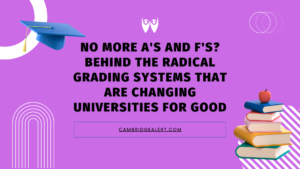
Grades have been a staple of college and school life for centuries. From gold stars on grade reports in grade school to GPA determinations in college, letter grades like A’s and F’s have governed how students are graded and see themselves. But in more and more universities, that may be changing. A grading revolution is afoot—one that’s testing whether antiquated grading is outdated, unfair, and even harmful. Let’s take a look at the new radical grading models transforming higher education.
The Flaw in Antiquated Grades
Why the A-F Scale is in the Crosshairs
Teachers have been grumbling about the shortcomings of the traditional A-F grading scale for years. Its detractors argue that:
- Grades are a reduction of learning in that they reduce complex understanding to one letter.
- They encourage competition at the expense of collaboration.
- They increase students’ stress and mental health concerns.
- They have a tendency to reward memorization rather than critical thinking and creativity.
Increasingly, studies are suggesting that grades actually do more harm than good—especially for students from underrepresented populations, who already face barriers in the education system.
Enter the Alternatives: What Are Radical Grading Systems?

Radical grading models seek to divert the emphasis of education from ranking to learning. Radical grading systems exist in numerous different forms, each with their own philosophy and structure.
1. Ungrading
Ungrading does away with grades entirely. Students receive rich feedback instead, and are tasked with self-assessing their work. Teachers can still award a final grade (to fulfill institutional needs), but this is usually done after close consultation with the student.
Benefits:
- Fosters self-reflection and intrinsic motivation.
- Promotes more active engagement with the content.
- Decreases performance-related anxiety.
Cons
- Can be hard to enforce in huge classes.
- Some students will feel uneasy without clear marks.
2. Contract Grading
With contract grading, students agree to deliver a predetermined amount of work in return for a minimum grade. Getting all the assignments done with effort, for example, might guarantee a B, and additional projects might be required for an A.
Advantages:
- Empowers students to assume responsibility for their learning.
- Clearly lays out expectations from the beginning.
Cons:
- May be experienced as transactional by some students.
- Requires explicit and detailed planning on the part of teachers.
3. Mastery-Based Grading
Also known as competency-based grading, this model allows students to resubmit and revise assignments until they demonstrate total mastery of a concept.
Pros:
- Puts actual learning ahead of deadlines.
- Encourages persistence and growth.
Cons:
- Time-intensive for teachers.
- Difficult to scale within departments.
Universities Leading the Way
Case Study: Brown University
Brown has traditionally offered a grading system that limits dependence on failing grades. Students may opt for a pass/fail system, which removes the pressure of going after A’s and enables them to experiment with new courses.
Case Study: Hampshire College
Hampshire College is famous for eliminating grades entirely. Students receive narrative evaluations instead of letter grades, and learning is guided by personal projects and goals.
Growing Trend Across Campuses
Other institutions, however, like the University of California system and tiny liberal arts schools, are toying with the grading alternatives within certain departments, especially in departments of the humanities and education schools.
Student Responses: Diverse but Hopeful
Student response to radical grading is diverse. Some embrace flexibility and reduced worry, while others are apprehensive about not having quantifiable requirements.
“It was weird at first not getting a grade,” says Emma, a sociology major at a university piloting ungrading. “But I’ve learned so much more because I’m focused on what I’m doing, not the letter I’ll get.”
However, some students worry about how alternative grades might affect graduate school applications or job opportunities, where traditional GPAs are still commonly requested.
Will This Revolution Last?

As more universities test out these radical new ways of grading, one question lingers in the air: Is this the future of academia, or a fleeting fad? Supporters claim the change couldn’t have come any sooner, that reforming assessment is the solution to a more equitable and rewarding academic experience.
But first, radical grading has to become mainstream. To do so, universities will need to:
- Retrain teachers and rethink curricula.
- Convince employers and grad schools of their validity.
- Create systems that can scale and are transparent.
Conclusion: Rethinking What Success Looks Like
Radical grading systems challenge us to rethink what education should be all about. Should it be about chasing A’s—or about growth, curiosity, and mastery? While not without challenges, these pilot models provide a glimpse of what a more student-centric university might look like.
Whether you’re a teacher, parent, or student, one thing’s for sure: how we grade is changing. And maybe that’s not a bad thing.
FAQs
Q: Do students still get a GPA under ungrading systems?
A: In most cases, yes. Even in ungrading models, schools still require a final letter grade for transcript purposes, but it’s calculated through discussion and reflection, rather than test scores.
Q: Are employers okay with non-traditional grades?
A: All employers embrace narrative assessments, especially when paired with strong portfolios or recommendations. Nonetheless, traditional GPA is still the standard requirement for most professions.
Q: Is ungrading practiced only in arts and humanities?
A: Although more common there, some schools of education and STEM programs are now experimenting with mastery-based grading and other variations.
